Demographic Situation
Hungary’s territory is 93,030 square km. Its population is 9 603 634 according to the latest census of 2022, its population density is 103 persons per km2, it is the 13th most populous and the 15th most densely populated country in the European Union. The country's population is declining slightly and its age structure is getting older, with the proportion of people aged 65 and over being 6% higher than the proportion aged under 15.
| Population trends | Population by sex and age |
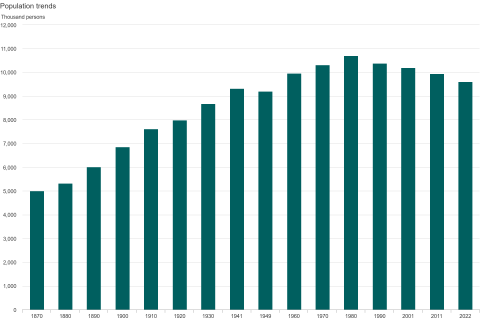
|
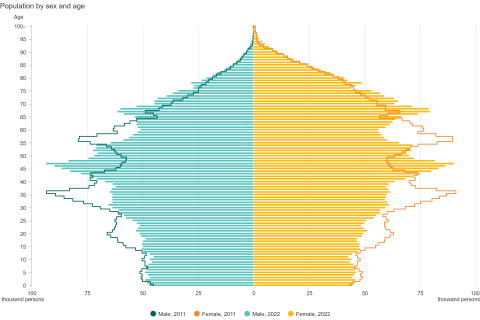
|
At the time of the 2022 census, 70% of the population lived in cities (17% in the capital, 53% in other cities) and 30% in villages. The population density is highest in Budapest and Pest county, and also in Komárom-Esztergom and Győr-Moson-Sopron counties. Somogy is the least densely populated county in the country.
| Population density |

|
Employment
In 2022, 49% of the population was employed, an increase of almost 10 percentage points since 2011. The number of unemployed in 2022 was 237 thousand, down 58% since 2011.
| Distribution of population by economic activity |
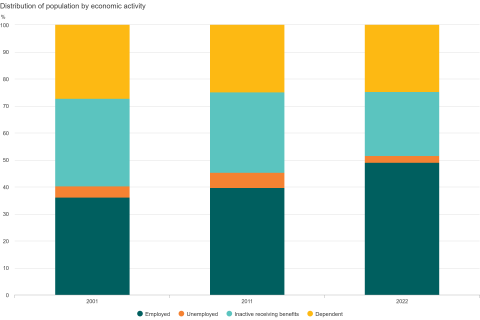
|
Immigration and migration flows
In 2022, 218 thousand foreign citizens were living in Hungary, an increase of 52% since 2011. The majority of foreigners living here (76%) came from European countries, and every second from a neighbouring country. Over the last decade, the number of persons coming from Ukraine has tripled, and the number from China and Slovakia has doubled. By contrast, the number of immigrants from Romania has fallen significantly.
The flow of Hungarian citizens has varied in the last two decades. While in 2011 12,413 Hungarian citizens left and 5,504 returned, between 2016 and 2022 the number of returnees exceeded the number of emigrants: in 2022, the year of the census, 28,825 emigrated and 38,634 returned to the country.

Source: Hungarian Central Statistical Office – Data on Immigration (A bevándorló külföldi állampolgárok az állampolgárság országa szerint), Emigration (Magyar állampolgárok vándorlásának összefoglaló adatai)
Official and minority languages
The official language of Hungary is Hungarian.
The Fundamental Law of Hungary recognises national and ethnic minorities as a constituent part of the state and grants them the right to cultivate their own culture, to use their mother tongue, to receive education in their mother tongue, to use their own language and to participate collectively in public life. The Act CLXXIX of 2011 on the Rights of National Minorities (2011. évi CLXXIX. törvény a nemzetiségek jogairól) lists 13 national minorities: Bulgarian, Croatian, German, Greek, Armenian, Roma/Gypsy, Polish, Romanian, Ruthenian, Serbian, Slovak, Slovene and Ukrainian. The additional costs of the public education of national minorities are covered by the state. There are also a number of minority language and culture programmes in higher education.
In the 2022 census, around 503,000 people identified themselves as belonging to a national minority. The most populous ethnic group in Hungary is the Roma, approximately 210,000 people. In 2022, the number of people with German ethnic affiliation was 143 thousand, 30 thousand Slovaks, 28 thousand Romanians and 25 thousand Ukrainians.
| Minority languages |
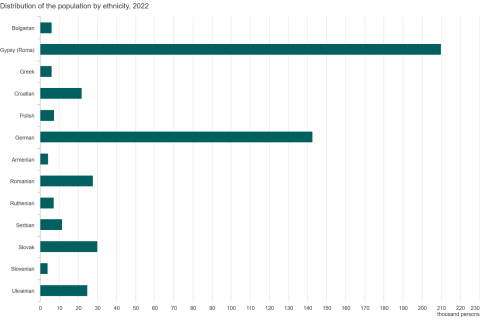
|
Religions
The Fundamental Law guarantees freedom of conscience and religion for Hungarian citizens.
In the 2022 census, 50% of respondents, 2.9 million people, identified themselves as Catholics, 16% as belonging to the Reformed Church and 3.1% as Evangelicals. 27% of respondents said they had no religion.
| Religions |
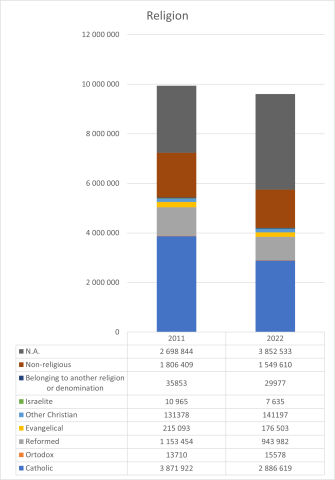
|
Compulsory ethics or religious and moral education was introduced in public education in 2013. The latter is provided by the churches, which train the teachers in their own higher education institutions.
Churches, as maintainers of public education, vocational education and training or higher education institutions, can provide education in accordance with their conscience and religious beliefs.
